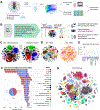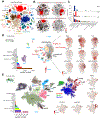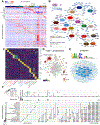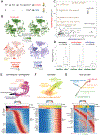Fly Cell Atlas: A single-nucleus transcriptomic atlas of the adult fruit fly
- PMID: 35239393
- PMCID: PMC8944923
- DOI: 10.1126/science.abk2432
Fly Cell Atlas: A single-nucleus transcriptomic atlas of the adult fruit fly
Abstract
For more than 100 years, the fruit fly Drosophila melanogaster has been one of the most studied model organisms. Here, we present a single-cell atlas of the adult fly, Tabula Drosophilae, that includes 580,000 nuclei from 15 individually dissected sexed tissues as well as the entire head and body, annotated to >250 distinct cell types. We provide an in-depth analysis of cell type-related gene signatures and transcription factor markers, as well as sexual dimorphism, across the whole animal. Analysis of common cell types between tissues, such as blood and muscle cells, reveals rare cell types and tissue-specific subtypes. This atlas provides a valuable resource for the Drosophila community and serves as a reference to study genetic perturbations and disease models at single-cell resolution.
Conflict of interest statement
Figures






References
Publication types
MeSH terms
Substances
Grants and funding
- MC_U105188491/MRC_/Medical Research Council/United Kingdom
- P30 EY026877/EY/NEI NIH HHS/United States
- T32 NS095939/NS/NINDS NIH HHS/United States
- R01 HL054732/HL/NHLBI NIH HHS/United States
- R37 HD038921/HD/NICHD NIH HHS/United States
- R01 AI095491/AI/NIAID NIH HHS/United States
- R01 DK128485/DK/NIDDK NIH HHS/United States
- ZIA DK015600/ImNIH/Intramural NIH HHS/United States
- R35 GM136665/GM/NIGMS NIH HHS/United States
- 200846/Z/16/Z/WT_/Wellcome Trust/United Kingdom
- R35 GM141885/GM/NIGMS NIH HHS/United States
- R01 EY013012/EY/NEI NIH HHS/United States
- R35 GM136433/GM/NIGMS NIH HHS/United States
- R01 GM061986/GM/NIGMS NIH HHS/United States
- R01 DK108817/DK/NIDDK NIH HHS/United States
- R01 HL149992/HL/NHLBI NIH HHS/United States
- R01 EY017916/EY/NEI NIH HHS/United States
- R00 AG062746/AG/NIA NIH HHS/United States
- R35 GM136348/GM/NIGMS NIH HHS/United States
- R01 HD059060/HD/NICHD NIH HHS/United States
- HHMI/Howard Hughes Medical Institute/United States
- R01 DC005982/DC/NIDCD NIH HHS/United States
- R01 EY022638/EY/NEI NIH HHS/United States
- T32 GM007790/GM/NIGMS NIH HHS/United States
- R01 DC014932/DC/NIDCD NIH HHS/United States
- R35 GM136270/GM/NIGMS NIH HHS/United States
LinkOut - more resources
Full Text Sources
Other Literature Sources
Molecular Biology Databases

